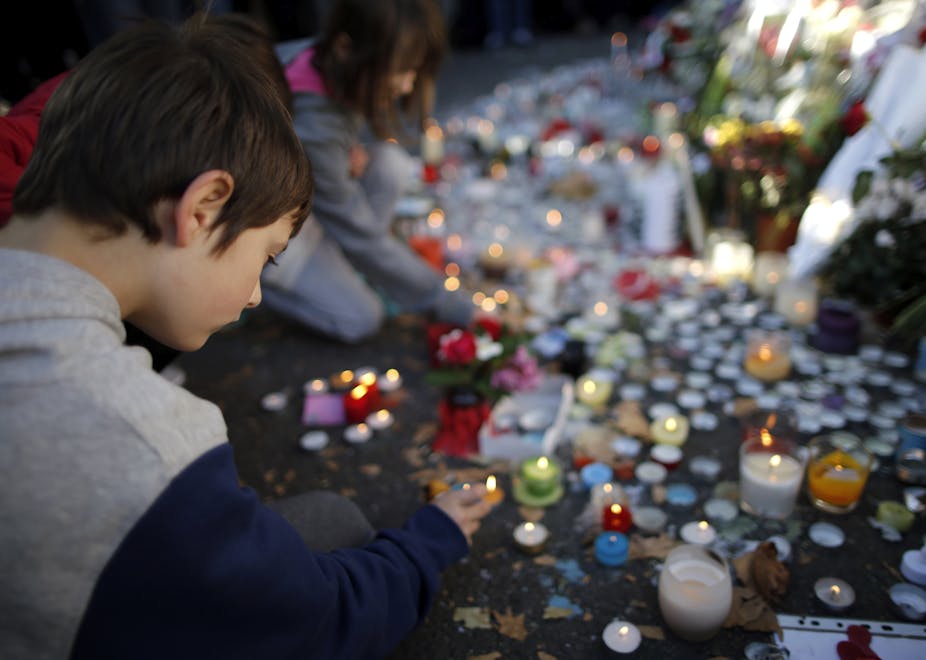Schools opened across France during three days of national mourning for the victims of the Paris attacks. This left many teachers to face the question: how best to talk about what had happened with students? Several teachers from a variety of levels and disciplines shared their thoughts with me.
While we are all helpless in the face of such horrors, each of us can contribute in our own way. All those who spoke showed that it’s possible to help children understand, even at the youngest age. One thing is clear: silence is no way to help them respond to the violence that took place in Paris.
Questions for teachers
Annabelle, who teaches at a middle school, described her thoughts, fears, and uncertainties about how to proceed:
Teachers are definitely concerned and full of questions ourselves. Should we speak of the attacks and if so, how? Is it appropriate for us to do so, or will we do more harm than good? How can we handle any extreme or unacceptable reactions from the students? If we open up a discussion, it will probably mean having to hear everything. How then to react?
Even as I’m thinking this, I suddenly realise that talking means being able to manage all the remarks while remaining professional, dignified, strong, solid, but … I feel close to tears, fragile.
After school on Saturday I asked my daughter if she talked in class about the attacks. She said, ‘No, the teachers said we had other things to do.’ I understood what they meant to say, but it hurt. Our students feel really concerned. I’d like them to start thinking about why these places were targeted, why this is an attack on freedom, and what tolerance means.
The need to reassure
Monique, director of a primary school, said:
Some students don’t understand what’s happening. The ‘not afraid’ attitude of some adults is foreign to them, they push away reality and withdraw into themselves. On the other hand, many students are affected by the fear they do sense in adults. Some feel stigmatised, perhaps in danger … We must reassure them, and not allow this atmosphere to darken even more.
Dany, a primary school teacher, decided to set up activities around symbols of peace, living together and cooperation rather than conflict or competition. She chose tasks that would develop social skills, and activities and games that encourage mutual respect, openness and negotiation.
The games all involved pursuing a common goal, where no one wins or loses, and we discover that it’s more fun to solve a challenge collectively than to do so alone. Or where they can cooperate to achieve a common goal, as with role-playing games, where every child is involved and can contribute to success.
The need to exchange and share
Carole, who teaches older children, chose to hang a large white sheet on the classroom wall. Using brightly coloured pens, the students drew what they heard, felt, and saw during the weekend. After, they sat in a circle and talked together. Some said nothing, but all had drawn on the sheet. Talk doesn’t always come easily, especially with the young.
In this class, there is a significant proportion of children for whom French is not the language spoken at home. We especially took their drawings into account, and then explained the events to help them understand: ‘What is an attack? Are you afraid to go to school? Did your mom and dad turn off the TV this weekend? If so, why?’
For Carole, as for many other teachers, taking time to express herself is essential, but it’s also important to listen to students’ anxieties and questions.
Fatma, who teaches English at a middle school, wrote out her plan:
- Listen
- Share
- Draw conclusions that have never been put forward!
In Valerie’s class, students read literary texts to help them better understand the situation today. The goal is to help them see that many great thinkers of the past, including Louis-Ferdinand Céline and Albert Camus, have written works that are relevant to issues of today.
For Nathalie, cinema will help students: “I want to show them an excerpt we’d planned from Day for Night,” the film by François Truffaut.
The need to engage for the long-term
At the end of the morning in kindergarten, the children in Carole’s class decided to write to children living in the neighbourhood that they’d heard had been attacked.
For Monique, what’s important is not just what you do on the first day, but also offering weekly activities that help develop a sense of others and mutual respect.
She emphasises the work of Serge Tisseron, a psychiatrist and researcher at the University of Paris 7. His Game of Three Figures is a role-play activity that involves three fictional characters — an aggressor, a victim and a bystander. In the game, students alternately play all three roles and then discuss them.
Monique felt it was particularly useful as a release from all the violence that had arrived through TV in the students’ homes. During a full month she’ll repeat the game weekly and adapt it to events as they develop. Other teachers plan exhibitions on peace and tolerance built by several classes and shown in the lobby of the school.
Those who submitted all these suggestions are just regular teachers, with their own doubts and fears. But they willingly shared their thoughts and plans with a firm desire to combat terror.
The names of the teachers interviewed have been changed and their responses were edited. Translated from the French by Leighton Walter Kille.


